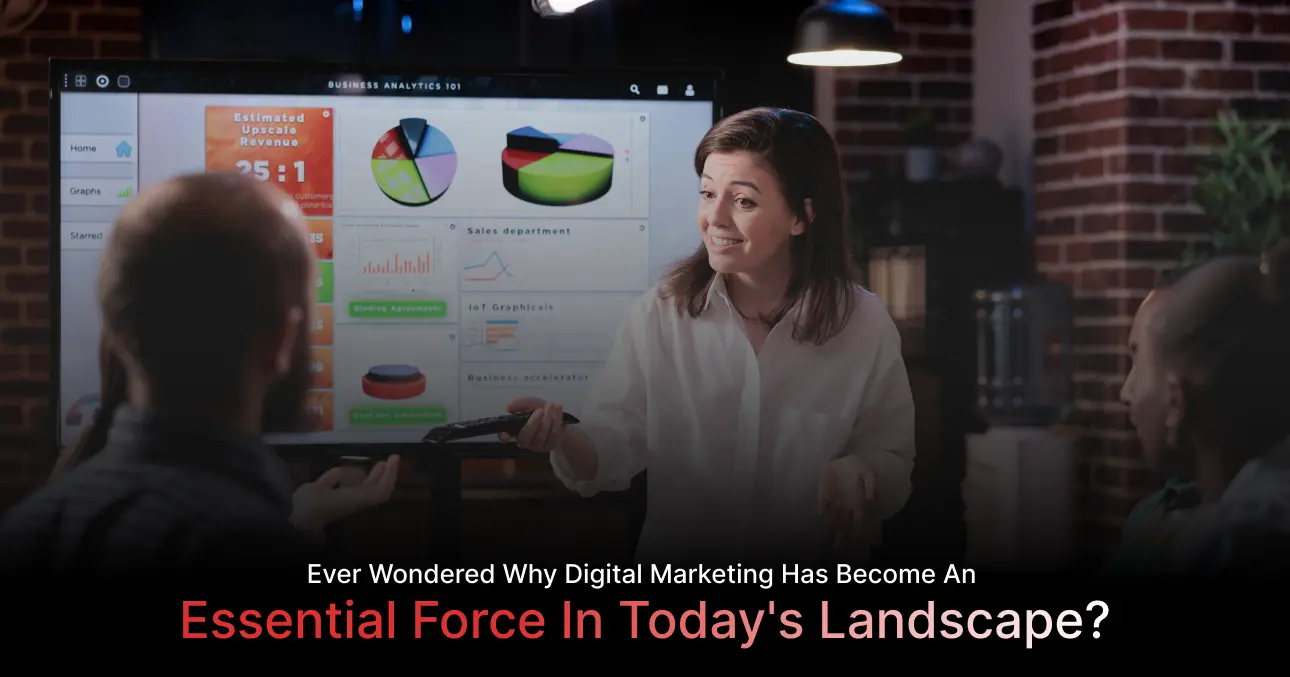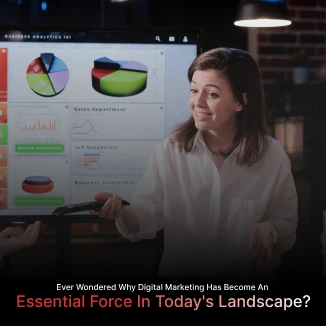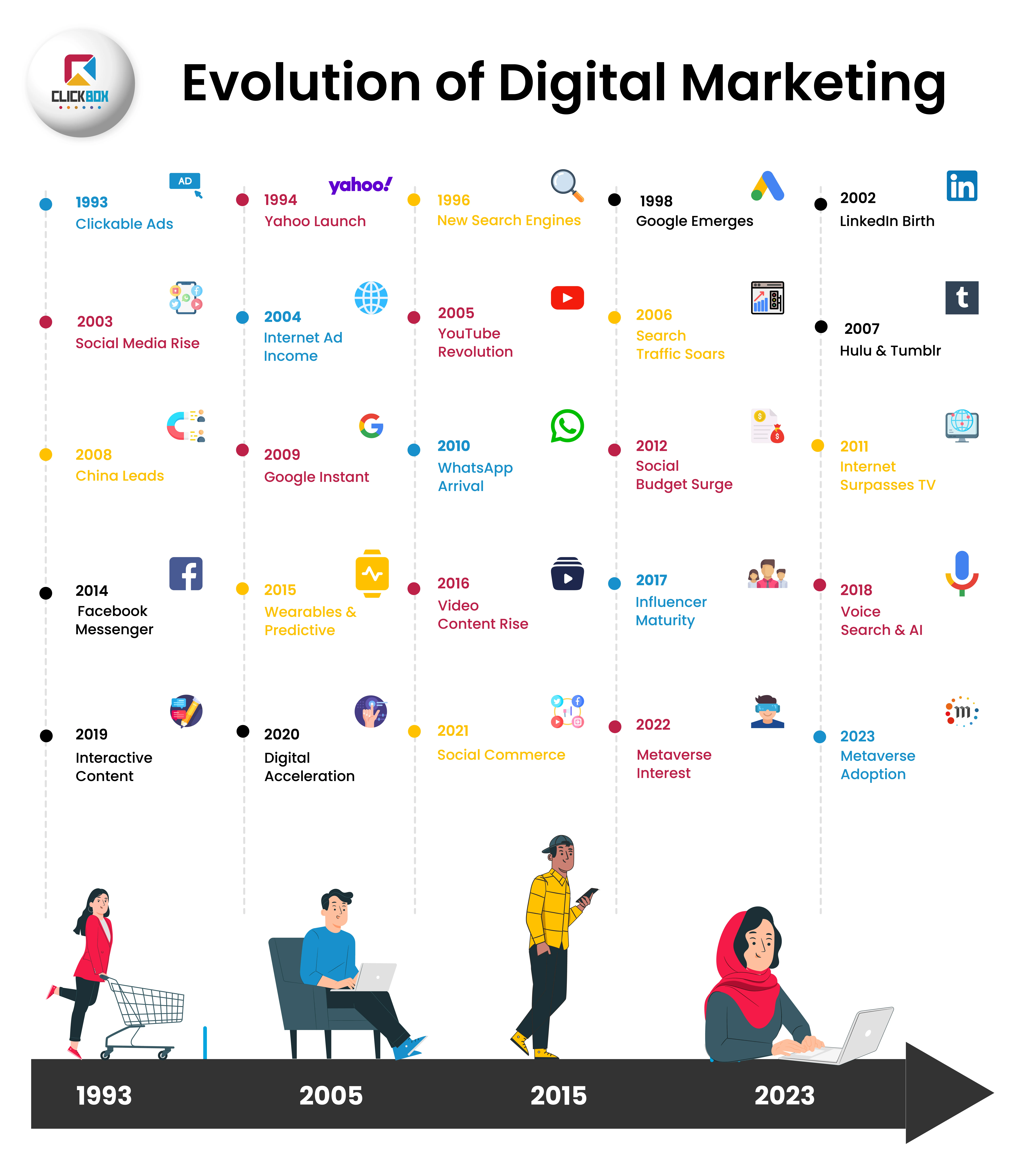

Ever wondered why digital marketing has become an essential force in today's landscape?
Digital marketing is very important in this day and age where people mostly contact and connect online. Customers are constantly interacting with brands on several online platforms, and this is happening to businesses of all sizes and in all kinds of industries. Businesses can reach their target audiences directly through digital platforms like social media, search engines, and email, thanks to digital marketing. Being seen isn't enough; digital marketing makes precise targeting possible, so companies can tailor their messages to specific groups of people. Because digital campaigns happen in real-time, changes can be made quickly to make sure that tactics continue to work in a digital world that is always changing. Digital marketing is basically what makes it possible for businesses to connect with their customers in a way that is personalized, measured, and has an effect.
What is Digital Marketing?
Digital marketing involves promoting and selling products and services using websites, apps, mobile devices, social media, search engines, and other digital channels. Digital marketing became popular in the 1990s as the internet developed. 55% of marketing is digital. In 2021, $436 billion was spent on digital ads, while only $196 billion spent on outdoor ads.
Evolution of Digital Marketing: The Timeline
● The 90s
Archie was the first search engine. It came out in the early 1990s. The search began. The next word was SEO, which means "Search Engine Optimisation."
The first web ads with pictures that could be clicked on came out in 1994. In 1997, the first clear-cut social networking site went live and had 3.5 million users. Many websites were made in the 1990s that people still use today. These are things like Google and Yahoo's web search, which both came out in 1998.
● People who were born between 1980 to 2000
There was a big economic bubble in the 2000s. But many businesses lost money when the boom grew and then burst from 2000 to 2002. As the economy got better after the boom in the 2000s, many new sites came out. These were the first forms of Facebook in 2004, MySpace and WordPress in 2003, and LinkedIn in 2002. Text message marketing on cell phones became more popular in the early 2000s.
● The Mobile Era
Marketing and sales grew in the second half of the decade, and Amazon's online sales topped $10 billion. With the rise of mobile devices, digital marketing has changed a lot, as have how people use and interact with it. Smartphones have changed how we get information, shop, and connect with brands. From making websites to writing material, businesses need to make sure they are mobile-friendly.
You can connect with people in a more personal way through mobile apps, and social media sites love content that is optimized for mobile devices and gets people's attention quickly. Businesses can send personalized messages thanks to location-based marketing and GPS technology. This is called contextual advertising. With short-form mobile movies, chat apps, and mobile shopping, this is a time of change that requires data-driven personalization. Companies need to be flexible, creative, and know how to connect with mobile customers in order to do well in the "Mobile Era."
● At this moment
The Bureau of Labour Statistics says that by 2026, the need for marketing jobs will grow by 10%, which is more than the average for all jobs. These days, 65% of the time people spend with digital material is on their phones. The market for online ads is worth about $200 billion right now, and 96% of that comes from Google AdWords. With about 3.1 billion users, social networking sites have been at the heart of the change in digital marketing. Because blogs and Instagram are so popular, influencers have grown into a $1 billion business. This business is only going to get bigger. Digital marketing is likely to grow over the next few years, and this interesting area will see a lot of new things happen.

The History of Digital Marketing
● 1993: The first ad that could be clicked on went up. The online magazine HotWired bought some of these to promote the magazine and get more people to subscribe. This was the start of the age of switching to digital marketing. New technologies were coming out, and Yahoo! was launched. This was the start of the real growth of digital marketing in 1994. In its first year, Yahoo got almost a million hits, which made business owners and marketers rethink how they approach digital marketing. They started to make changes to their website so that it would meet the needs of search engines.
● Lou Montulli came up with cookies in 1994. When you visit a website, a web server sends cookies, which are small data packets, to your computer. They let you get into websites and keep track of what you do, like which websites you visit and what you do. This would let companies know what you're interested in so they can give you more relevant ads.
● Alexa , LookSmart, and HotBot were new search engines that came out in 1996, but they helped the number of online tools available grow. These sites were some of the first attempts to find your way around and organize the huge amount of information on the internet. This was a crucial year in the history of search technology.
● Google, Microsoft's MSN engine, and Yahoo web search all came out in 1998, marking the start of the big digital companies. This important event marked the start of a new era. It changed the way people search the web and made it possible for these tech giants to take over the digital world.
● 1999: Web 2.0 was released, letting users not only read material but also upload and share it. This was a crucial year in the history of digital marketing. Users were no longer just silent viewers; they were taking part. This made it possible for a lot of people to share things, create social networks, and so on. During this time, sites like Wikipedia, Facebook, and blogs began to appear.
● 2000: There was a lot of worry about how computers would handle the Y2K situation, which is the change in the date at the start of the new millennium. There was an accident, and many of the small search engines disappeared, making way for the big ones to take the lead for good.
● It was started in 2002 as a professional social networking site called LinkedIn. It helped recruiters find qualified people and allowed qualified people to find recruiters.
● 2003 MySpace was the first social networking site to come out. Orkut came next, and then Facebook. Companies began to pay close attention and understood the chances these sites gave them. To get in touch with thousands of people quickly, they could do it for a very low cost. Businesses started to actively market their goods and services on these sites, which marked the start of a new era in business.
● There was almost $3 billion in income from internet ads in the United States alone in 2004. The digital marketing business not only got started but also made itself known and let everyone know it was here to stay.
● In 2005 YouTube out as a revolutionary way to share videos. It quickly became a worldwide phenomenon with millions of loyal users and fans. Its effects have changed how digital material is made and how it is used, making it an essential part of the online experience.
● This year, 2006 saw a huge jump. In just one month, search engine traffic reached nearly 6.5 billion. To keep up with Google and Yahoo, Microsoft got rid of MSN and started Live Search. This year also saw the start of Twitter and the rise of split tests in marketing. Amazon made more than 10 million dollars in online sales.
● The digital world grew when the messaging site Tumblr and the streaming service Hulu came out in 2007. These platforms made big changes to online conversation and entertainment, making the internet even more diverse and ever-changing.
● The US lost its title as the country with the most internet users to China in 2008. This year saw the start of the music-sharing site Spotify.
● In 2009, the digital realm experienced a notable transformation with the advent of Google Instant, enabling users to observe search engine outcomes in real time as they entered their queries. This feature transformed the search experience by offering immediate and dynamic access to information, establishing a new benchmark for online search interactions.
● The messaging program WhatsApp was introduced for phones in 2010, marking the beginning of a new era in mobile communication. Over time, WhatsApp Business accounts have offered businesses flexible tools to promote and sell their products and services, further incorporating messaging platforms into the digital marketing field.
● In 2011,there was a significant change as the number of internet users, particularly among the younger generation, surpassed the number of TV viewers. This event represented a noteworthy achievement in the realm of digital conduct. In addition, Google launched Google+ and Google Panda, which had a significant impact on social networking and search engine algorithms, respectively, changing the online environment.
● In 2012, there was a significant rise in social media marketing, with budgets seeing a noteworthy growth of 64%. This highlights the increasing acknowledgment of the significant impact that social platforms have on digital marketing tactics, indicating a trend towards more expenditure in online interaction and brand promotion
● 2014 was the year that Facebook Messenger and personalized ads on LinkedIn other social networks came out. Also, this was the year when people used their phones more for reading and shopping than their computers.
● The year 2015 was a big one for digital marketing. That year, "wearables" and predictive technology came out, starting a new age of personalized experiences. During this time, active content marketing strategies and direct marketing saw a lot of growth, showing that the industry as a whole was open to new ways to connect with and involve audiences.
● With the launch of Facebook Live and Instagram Stories in 2016, there was a big increase in video material. This set the stage for visual storytelling to become the most popular form of storytelling.
● In 2017, influencer marketing reached a more mature stage as brands worked with influencers on a wider range of channels. Augmented Reality (AR) and Virtual Reality (VR) technologies started to show up in advertising efforts as well.
● With the rise in popularity of voice-activated products like Google Home and Amazon Echo, voice search optimization became the most important thing in 2018. During this time, Artificial Intelligence (AI) was also used more in marketing tactics, which improved personalization and analytics better.
● There was a lot of interactive material in 2019, and the Stories format kept changing, moving beyond Snapchat to become a common feature on Instagram and WhatsApp.
● Due to the global pandemic, 2020 saw a faster move to digital channels. This highlighted the significance of e-commerce, short-form video platforms like TikTok, and live streaming becoming more important.
● It was a big year for social commerce in 2021, and digital marketing continued to change as third-party cookies were phased out. There was more focus on user safety and doing the right thing with data.
● As of 2022, people were interested in exploring the metaverse more, which opened up new ways to have engaging digital experiences. A privacy-first approach continued to shape digital marketing tactics, emphasizing open and user-centered methods. The years after 2015 show how dynamic digital marketing is. To be successful in this ever-changing field, you need to be able to adapt to new tools and keep the user experience in mind.
● In 2023, digital marketing is going into the metaverse, which gives brands chances for immersive interaction that has never been seen before. Marketers are using the digital world to change the way people connect through virtual events, unique branding spaces, and virtual transactions. The metaverse is a new area for influencer marketing, virtual reality, and personalized ads. It is creating a changing environment where people can be creative with no limits. As this change happens, protecting data privacy will remain a very important issue. This is a very important time for digital marketers as they navigate the metaverse.
How Digital Marketing Works
Today, companies use a strategic mix of online channels like email, search engines, and social media to connect with their target audiences through digital marketing. Insights based on data are very important because they allow real-time analysis of user behavior for better marketing optimization. Personalization is essential because it makes sure that the material is tailored to each person's tastes.
Digital marketers make brands more visible and build meaningful connections with customers by constantly adapting. This increases conversions and builds long-term loyalty in the always-changing digital world. In 2020, the world market for digital advertising and marketing was worth $350 billion. By 2026, it's expected to be worth $786.2 billion.
Why is digital marketing the key to unlocking success in every click and swipe?
Traditional marketing was the key to every business's success a few years ago. Things changed a lot when internet marketing came into the business world. You can tell how important digital marketing is because these days every business has a good social media image. It's not a choice; digital marketing is what you need right now. It has given people many new ways to sell goods and services to them ever since it began. Digital marketing has become a very important part of businesses over the years.
You are way behind the times if you don't have a personalized website or a Facebook page. If you want to keep up with the rest of the world, you should go digital before someone else does. Now that the internet is everywhere, digital means can reach more people than ever before.
I'm going to tell you some of the main reasons why your business needs digital marketing in this article:
1. Digital ads can reach more people
This is the most important good thing about digital media. You will have to spend a lot of money to reach a huge crowd, just like with traditional marketing. Digital marketing that is done right can easily reach millions of people. Let us look at a simple billboard and a paid Facebook ad as an example. A normal billboard in a commercial area costs millions of dollars for a few days. On the other hand, a Facebook ad that costs millions of dollars will get a lot of attention from people all over the world.
2. The people you want to reach can be reached
If you hand out papers to people in your area, you can be sure that not all of them will be interested in the product or service you are promoting. This is because not all of them are the intended viewers. Digital marketing not only lets you reach your ideal customers, but it also helps your business make more sales.
3. Digital marketing earns more and costs less
Every business wants to make as much money as possible while spending as little. Social media marketing, business emails, web marketing, content marketing, blogs, and other things are all types of digital marketing. All of these choices are cheaper than the old way of selling. With this benefit, a company can quickly make more money and cut down on the costs of advertising.
4. SEO is what you need right now
These days, a lot of marketing tools are used. When it comes to Google AdWords, terms are overused. Businesses can easily move up in the search engine rankings now that SEO methods have come a long way. If you need SEO help for your business, you can go to the Social Market Way New York Office. These kinds of businesses offer great services to people who need them.
Types of Digital Marketing
Different areas of digital marketing have different ways that they can be used to connect with digital media more effectively. You can learn more about these strategies if you want to work in digital marketing as a job.
1. Search Engine Optimization
Search engine optimization, or SEO, is more of a marketing tool than a marketing method. It makes the web pages look good on the search engine results page (SERP) so that websites get the best score possible. This tool works best when it has four things: engaging users, good content, many good links coming in, and being mobile-friendly. Google has 86.86 percent of the world search engine market right now
2. Content Marketing
There are a lot of statistics that show that relevant and interesting information can strengthen relationships through any method. In contrast to standard advertising, content marketing tries to get leads to become customers. Blog posts, e-books, newsletters, video or audio transcripts, white papers, and infographics are some kinds of content.
3. Social Media Marketing
Using social media to start conversations about your business and get more people to visit your website is called social media marketing. It has built-in engagement measures, like the number of shares, comments, or clicks to your website, that help you learn more about your audience. Moreover, half of the world's population (58.4%) now utilizes social media. Every day, the average person spends 2 hours and 27 minutes on social media.
4. Pay-Per-Click Marketing
Pay-per-click, or PPC, is a way to market online that gets you paid every time someone clicks on one of your ads. With this method, you can pick your desired conversions and follow them through the digital marketing platforms you've chosen to see how your campaign is going.
5.Affiliate Marketing
Using social media to start conversations about your business and get more people to visit your website is called social media marketing. It has built-in engagement measures, like the number of shares, comments, or clicks to your website, that help you learn more about your audience. When you use this digital marketing approach, you can make money by promoting someone else's business. Based on a revenue-sharing plan, when people buy the things you promote, you can get paid a commission.
6. Influencer Marketing
Like affiliate marketing, influencer marketing depends on getting a well-known person with a lot of followers to tell their followers about your goods or services. This is a good way to reach a bigger and more diverse group of people.
7.Marketing Automation
Software is used in this method to make ads more relevant and effective in digital marketing efforts. It also makes the connection between you and your viewers stronger.
8. Email Marketing
This includes sending an advertising message and making sure people who might buy it click on it. It lets you customize the subject line and text of the email to connect with and interest subscribers. On the other hand, marketing emails have a way to unsubscribe, and they combine promotional and business emails.4 billion people use email every day. By 2025, this figure is anticipated to increase to 4.6 billion.
9.Mobile Marketing
Through mobile marketing, you can keep your target audience entertained on their phones and computers. Here, the material is optimized for mobile devices so that marketing will be easy and long-lasting, and customers will be able to interact with it well, which will increase sales and revenue.
Does digital marketing work for all businesses?
Digital marketing works for all industries and businesses. Digital marketing requires buyer personas and quality online content, regardless of what your firm sells. That doesn't mean all firms should use the same digital marketing strategy.
1.Digital B2B Marketing If your business-to-business (B2B) digital marketing activities generally focus on online lead generation to get people to talk to a salesperson. Your marketing plan may aim to generate high-quality leads for your salespeople via your website and digital platforms. Beyond your website, you'll likely target business-focused channels like LinkedIn, where your demographic is online.
2.Digital B2C Marketing If your firm is business-to-consumer (B2C), depending on your items' pricing point, your digital marketing goal may be to attract visitors to your website and convert them into consumers without speaking to a salesperson. You're probably less interested in "leads" and more in accelerating the buyer's journey from website to purchase.
Your product features may be higher up in the marketing funnel than for a B2B business, requiring greater calls-to-action to encourage orders.B2C organizations value Instagram and Pinterest more than LinkedIn. "
In conclusion
The history of digital marketing has been a journey of change that matches the fast pace of technological progress and changes in how people behave. From the early days of selling things on the internet to the complex, data-driven strategies used today, digital marketing has always changed to keep up with the ever-changing digital world. As time has gone on, search engine optimization, social media's growth, AI's use, and the study of immersive technologies like AR and VR have all changed the field and made it more complex and linked. We can learn from the past about how resilient and flexible digital marketing is as we move forward. More new ideas will come up in the future, so digital marketers need to stay flexible and aware of new tools, trends, and their audiences' changing needs.
Finally, as you try to figure out the complicated world of digital marketing, Clickbox Agency is ready to be your one-stop shop. We are your trusted partner in creating a digitally successful journey for your business. We are experts in SEO, PPC, content marketing, social media, app promotion, and email campaigns. Clickbox is where innovation meets impact to help you improve your online profile. In an era where adaptation is key, Clickbox Agency is the compass that guides companies through the intricacies of the digital landscape, helping them connect, engage, and thrive. At Clickbox, we're not just marketers; we're architects of digital excellence, crafting success stories, one click at a time.
John Click
Digital Marketer | SEO Copywriter | Content Strategist
Experienced digital marketer with a proven track record in creating compelling content that not only engages audiences but also drives conversions and enhances SEO visibility. My expertise extends beyond marketing strategy to crafting persuasive narratives that resonate with your target audience. I combine data-driven strategies with captivating writing to deliver measurable results, ensuring your brand shines in the digital landscape.



 Digital Marketing
Digital Marketing


 Digital Marketing
Digital Marketing Digital Marketing
Digital Marketing



